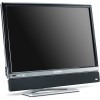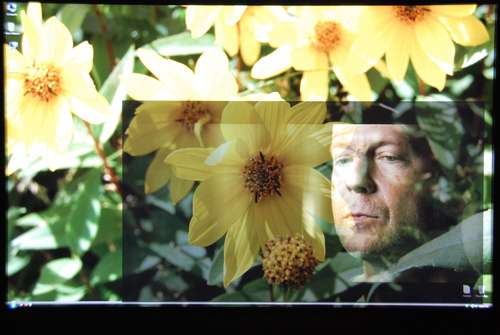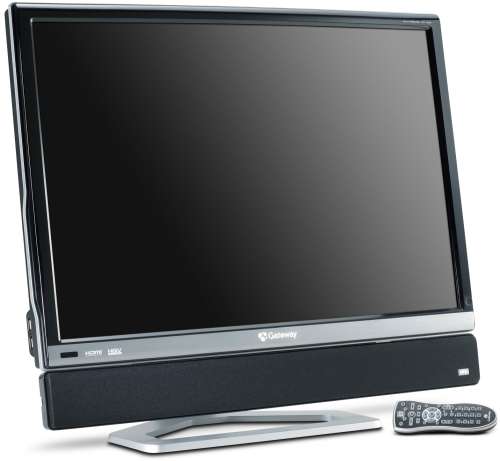- Qualcomm Launches Snapdragon 4 Gen 2 Mobile Platform
- AMD Launches Ryzen PRO 7000 Series Mobile & Desktop Platform
- Intel Launches Sleek Single-Slot Arc Pro A60 Workstation Graphics Card
- NVIDIA Announces Latest Ada Lovelace Additions: GeForce RTX 4060 Ti & RTX 4060
- Maxon Redshift With AMD Radeon GPU Rendering Support Now Available
Gateway XHD3000 30-inch Wide-Screen

Gateway, not content to let Dell and others hog the limelight in the display market, have recently launched their XHD3000 monitor. It offers a wide-range of connectivity options along with bright picture and an incredible upscaler. When said and done, this is one model we can heartily recommend.
Page 3 – Movie Testing, Final Thoughts
For movies, I used the Playstation 3’s built-in Blu-ray player and used both Casino Royale and Die Hard: Live Free or Die Hard. Though very difficult to tell in the photos, the upscaler again performed well here and delivered crisp video with great color. Some of the photos make the image look brighter than it actually was thanks to a slower shutter speed, but I can say the movies looked quite natural overall.
I watched through Die Hard: LFoDH with a friend and we sat about 5 feet from the display. It’s at that point when the image quality looks even better. If up close, you can quicker notice any imperfections, but sitting back at a comfortable level, the nice image quality becomes more apparent.
Blacks were very black, which was helped by the fact that this monitor displayed almost non-existent backlight-bleeding. Notice the second image especially… the top end bottom edges of the wide-screen format movie show absolutely zero signs of this.
Standard DVD’s of course won’t look spectacular on most new televisions/displays, and the same rule applied here. The upscaler did a fare job on those, but movies of course have a lot more “pop” in a high-definition format.
Personally, I can’t think of a true need for PIP on most any TV/display, but I am apparently not the target audience for the feature. Regardless of what connection you are using, you are able to turn to PIP mode using any connection as the primary and any as the secondary. This PIP window can be moved to any side of the display and it’s size can be increased as well.
The largest the PIP window can get is what’s seen in the above photo. As you can see, the image is transparent, but this is another feature. You have the option to set it at 0% transparency up to 75%, in incriments of 25%. This could be useful if you had an IM conversation going on your Windows desktop and wanted to watch a move on an external box at the same time.
Final Thoughts
When I first saw this display at DigitalLife, I was hoping that once I had one in the lab, I’d be just as pleased with it. The truth is, I was so impressed by this monitor there, that I half-expected to get back home and find it not perform as well outside of the staged environment. Luckily, my skeptical nature proved me wrong.
At the time this monitor was released, the two biggest selling features was the upscaler and also the fact that it was the brightest 30-inch display on the market. Though I deal with personal photography images, I tend to be drawn more towards brighter displays than more “natural” color, as wrong as that might be. It’s when the two are put together (like on Dell’s 3008WFP) that it’s a perfect combination.
The upscaler on the XHD3000 is impressive… very impressive. One reason I was so intrigued by the display was because I play an older MMORPG (Asheron’s Call) which maxes out at 1920×1200 resolution. On the Dell 3007WFP-HC I reviewed before, playing the game at it’s max resolution was hard. Because I was using a non-standard resolution, the fonts were bleeding and tough on the eyes, along with overall blotchiness.
The upscaler here fixes all of that. Since I’ve had this display here, I’ve played quite a bit of that MMO without issue. Even though I am using a non-standard resolution, the fonts and in-game graphics are just fine… a very nice advantage. Generally speaking, any game at 1920×1200 on this display will almost look native (2560×1600) thanks to the upscaler.
You can of course go lower, and even then the upscaler impressed me greatly. At resolutions below 1920×1200, the upscaler does it’s job well, but the game won’t look as stellar. This is primarily due to the fact that the upscaler has less pixels to work with, while 1920×1200 offers plenty. But still in the end, low resolutions look better on this display than any other out there.
Overall, the upscaler is outstanding, but there is one caveat. Whenever using a non-native resolution, the monitor loses its overall brightness. While it’s 400 cd/m2 at native, I assume it to be closer to 300 cd/m2 when using a non-native setting. Still not horrible, but retaining the monitors full brightness would have been great. This could be caused by the upscaler chip, I’m unsure.
Upscaling all aside though, this monitor proved to be the best one I’ve ever laid my hands on, and for that, I am awarding it an Editor’s Choice award. It offers great image quality, fantastic brightness (at native), an incredible upscaler chip and a huge assortment of connections. Though slightly expensive, at $1,699, you do get what you pay for.
As I mentioned in the intro, the leading competition to the XHD3000 is Dell’s recently-launched 3008WFP. That display retails for $1,999 and offers a 110% color gamut, 3000:1 contrast ratio and also includes an upscaler chip of some sort. We should have this display in our labs in the coming month, so we’ll see at that time how it stacks up to this Gateway.
Kudos to Gateway for showing us that they mean business with this monitor. Now bring on a high-gamut version!
Please?
- Pros
- Great image, even better resolution
- Bright 400 cd/m2 panel
- Silicon Optix Realta HQV upscaler chip is brilliant
- DVI, VGA, Component, Composite, HDMI… it’s all here
- Included remote control is helpful
- Included soundbar is a worthy addition
- Virtually no backlight-bleeding
- Cons
- Brightness lowers when in non-native resolution
- Cannot be heightened or lowered
- On-Screen-Display is robust, but sometimes clunky
- Linux support is lacking, but should be fixed with a firmware update
If you have a comment you wish to make on this review, feel free to head on into our forums! There is no need to register in order to reply to such threads.

|
|
Support our efforts! With ad revenue at an all-time low for written websites, we're relying more than ever on reader support to help us continue putting so much effort into this type of content. You can support us by becoming a Patron, or by using our Amazon shopping affiliate links listed through our articles. Thanks for your support!









